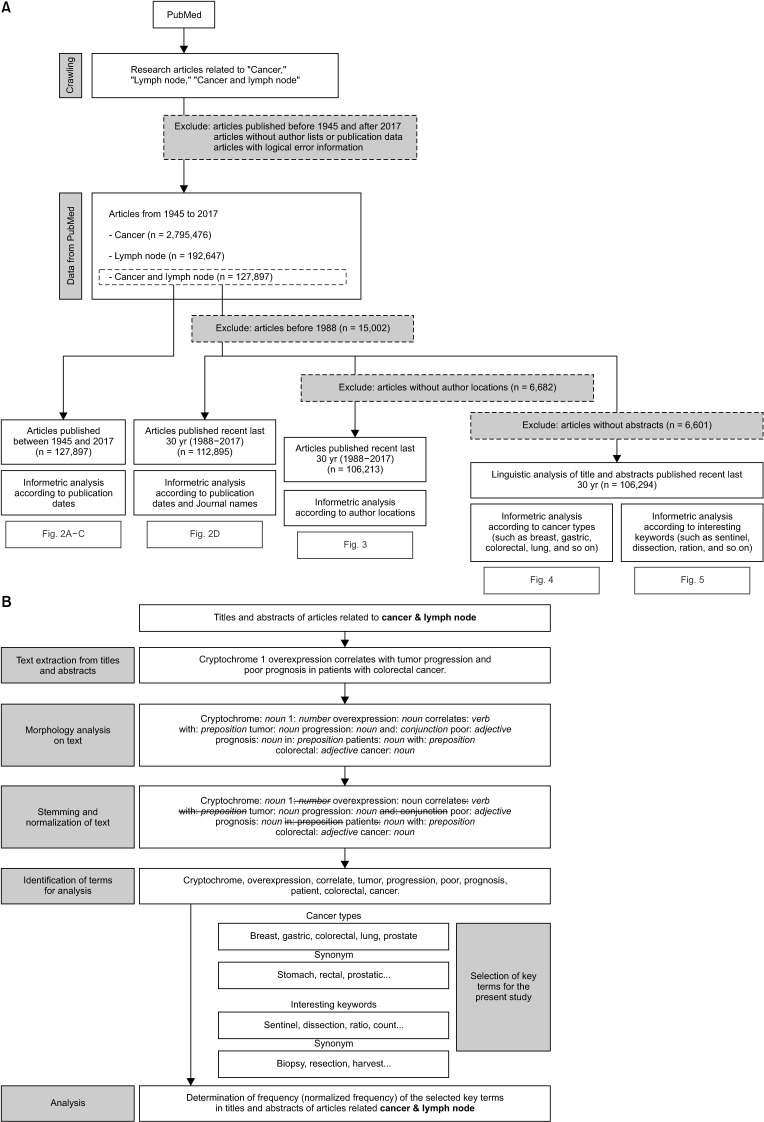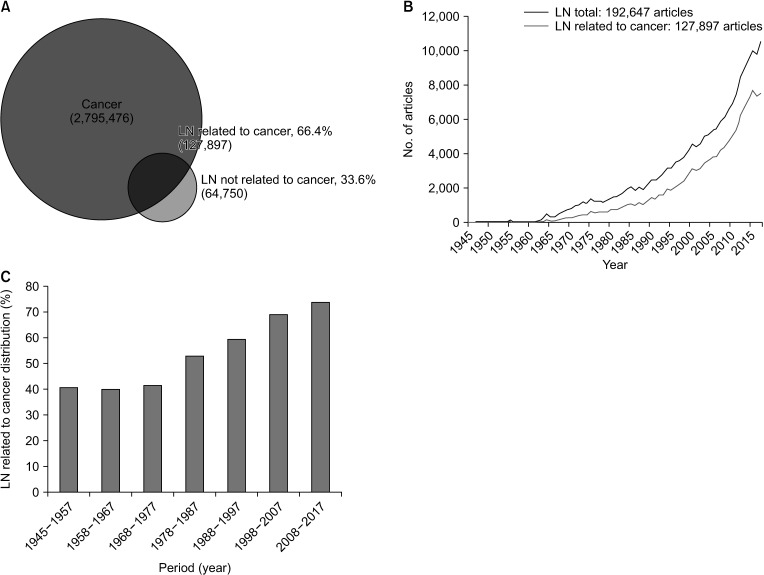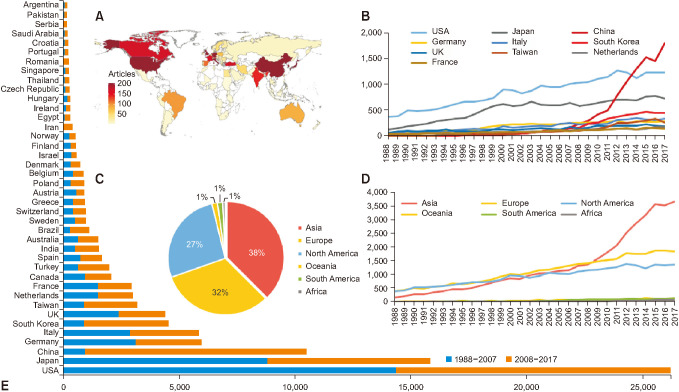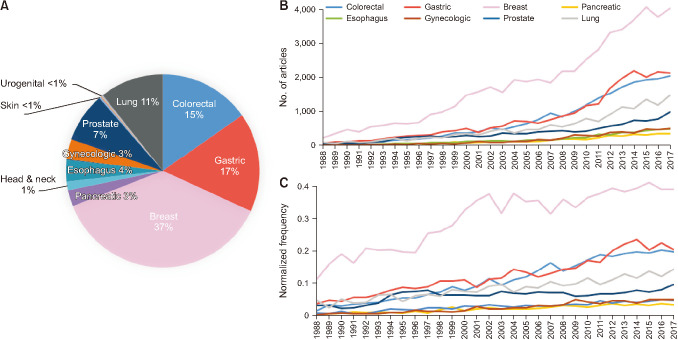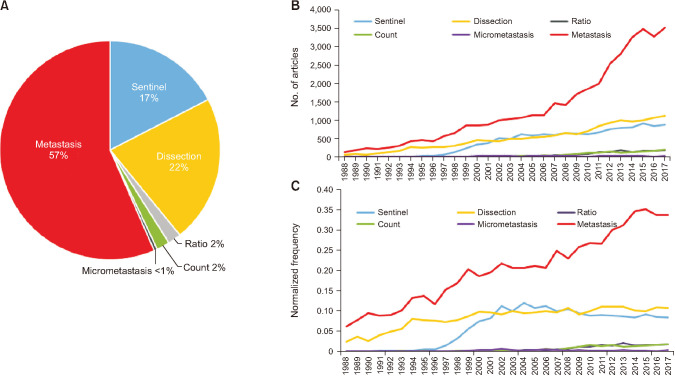Ann Surg Treat Res.
2020 Nov;99(5):305-313. 10.4174/astr.2020.99.5.305.
Chronologic trends of cancer-related lymph node research in PubMed: informetrics analysis
- Affiliations
-
- 1Department of Library and Information Science, Jeonbuk National University, Jeonju, Korea
- 2Graduate School of Archives and Records Management, Jeonbuk National University, Jeonju, Korea
- 3Department of Preventive and Public Health Dentistry, College of Dentistry, Wonkwang University, Iksan, Korea
- 4Department of Preventive Dentistry, School of Dentistry, BK21 Program, Jeonbuk National University, Jeonju, Korea
- 5Department of English Language and Literature, Jeonbuk National University, Jeonju, Korea
- 6Department of Statistics, Jeonbuk National University, Jeonju, Korea
- 7Department of Surgery, Jeonbuk National University Medical School, Jeonju, Korea
- 8Research Institute of Clinical Medicine of Jeonbuk National University, Jeonju, Korea
- 9Institute of Medical Information Convergence Research in JBNU, Jeonju, Korea
- KMID: 2508328
- DOI: http://doi.org/10.4174/astr.2020.99.5.305
Abstract
- Purpose
Given the long history of investigation into cancer and its relevance to the lymph node (LN), it would be meaningful to plot the trends of research on cancer-related LN.
Methods
Queries such as “cancer,” “lymph node,” and “cancer and lymph node” were submitted to PubMed to collect articles on cancer and LN published between 1945 and 2017. The collected articles were then extracted by an automatic web crawler and examined through informetrics and linguistic analysis.
Results
The number of articles related to cancer was 2,795,476 and 127,897 articles (4.6%) were found to be relevant to LN. With regard to cancer types, breast cancer was the most studied (37%), followed by gastric cancer (17%). With regard to the subjects in which the surgeon is interested, LN metastasis (57%) was found to be the topic most discussed, followed by LN dissection (22%) and sentinel LN (17%). Publications on LN metastasis gradually increased over time from 1988 to 2017 although those on sentinel LN and LN dissection have stagnated since the early 2000s.
Conclusion
Although research on cancer was abundant, only a small portion was dedicated to investigating its relevance to LN. Western countries had led the research on cancer-related LN, but Asian countries began to participate as major players, expanding their contributions. While LN metastasis, one of the major cancer-related LN topics, showed a steady increase, those involved in oncologic surgery such as LN dissection and sentinel LN did not.
Keyword
Figure
Reference
-
1. Stacker SA, Baldwin ME, Achen MG. The role of tumor lymphangiogenesis in metastatic spread. FASEB J. 2002; 16:922–934. PMID: 12087053.2. Pereira ER, Jones D, Jung K, Padera TP. The lymph node microenvironment and its role in the progression of metastatic cancer. Semin Cell Dev Biol. 2015; 38:98–105. PMID: 25620792.3. Halsted WS. I. The results of radical operations for the cure of carcinoma of the breast. Ann Surg. 1907; 46:1–19.4. Wormell I. Informetrics: an emerging subdiscipline in information science. Asian Libr. 1998; 7:257–268.5. Tague-Sutcliffe J. An introduction to informetrics. Inf Process Manag. 1992; 28:1–3.6. Beninger P, Ibara MA. Pharmacovigilance and biomedical informatics: a model for future development. Clin Ther. 2016; 38:2514–2525. PMID: 27913029.7. Charidimou A, Fox Z, Werring DJ, Song M. Mapping the landscape of cerebral amyloid angiopathy research: an informetric analysis perspective. J Neurol Neurosurg Psychiatry. 2016; 87:252–259. PMID: 26071214.8. Falagas ME, Pitsouni EI, Malietzis GA, Pappas G. Comparison of PubMed, Scopus, Web of Science, and Google Scholar: strengths and weaknesses. FASEB J. 2008; 22:338–342. PMID: 17884971.9. Oh HJ, Oh HW, Lee DW, Kim CH, Ahn JY, Kim Y, et al. Chronologic trends in studies on fluoride mechanisms of action. J Dent Res. 2017; 96:1353–1360. PMID: 28657808.10. Organisation for Economic Co-operation and Development (OECD). Main science and technolog y indicators (2018) [Internet]. Paris: OECD;2018. cited 2019 Feb 28. Available from: http://www.oecd.org/sti/msti.htm.11. National Cancer Institute. Funding for research areas [Internet]. Bethesda, MD: National Cancer Institute;2018. cited 2019 Feb 28. Available: https://www.cancer.gov/about-nci/budget/fact-book/data/research-funding.12. Leong SP. Paradigm of metastasis for melanoma and breast cancer based on the sentinel lymph node experience. Ann Surg Oncol. 2004; 11(3 Suppl):192S–197S. PMID: 15023750.13. Hellman S. Karnofsky Memorial Lecture: natural history of small breast cancers. J Clin Oncol. 1994; 12:2229–2234. PMID: 7931493.14. Mocellin S, Nitti D. Lymphadenectomy extent and survival of patients with gastric carcinoma: a systematic review and meta-analysis of time-to-event data from randomized trials. Cancer Treat Rev. 2015; 41:448–454. PMID: 25814393.15. Bertero L, Massa F, Metovic J, Zanetti R, Castellano I, Ricardi U, et al. Eighth edition of the UICC classification of malignant tumours: an overview of the changes in the pathological TNM classification criteria: what has changed and why? Virchows Arch. 2018; 472:519–531. PMID: 29209757.16. Vallbohmer D, Oh DS, Peters JH. The role of lymphadenectomy in the surgical treatment of esophageal and gastric cancer. Curr Probl Surg. 2012; 49:471–515. PMID: 22793506.17. Mocellin S. The effect of lymph node dissection on the survival of patients with operable gastric carcinoma. JAMA Oncol. 2016; 2:1363–1364. PMID: 27442439.18. Nieweg OE, Uren RF, Thompson JF. The history of sentinel lymph node biopsy. Cancer J. 2015; 21:3–6. PMID: 25611772.19. Giuliano AE, Gangi A. Sentinel node biopsy and improved patient care. Breast J. 2015; 21:27–31. PMID: 25546431.20. Read TE, Fleshman JW, Caushaj PF. Sentinel lymph node mapping for adenocarcinoma of the colon does not improve staging accuracy. Dis Colon Rectum. 2005; 48:80–85. PMID: 15690662.
- Full Text Links
- Actions
-
Cited
- CITED
-
- Close
- Share
- Similar articles
-
- Clinical Implication of Lateral Pelvic Lymph Node Metastasis in Rectal Cancer Treated with Neoadjuvant Chemoradiotherapy
- The Number of Removed Lymph Nodes for an Acceptable False Negative Rate in Sentinel Lymph Node Biopsy for Breast Cancer
- Advantages of Splenic Hilar Lymph Node Dissection in Proximal Gastric Cancer Surgery
- Significance of Lymph Node Metastasis in Early Gastric Cancer
- Current Status and Scope of Lymph Node Micrometastasis in Gastric Cancer

